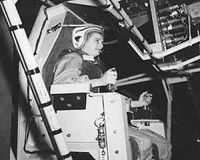 |
Moscow, Beijing (SPX) Oct 08, 2009 Boeing and Russian aerospace company RSC-Energia signed a memorandum of understanding (MOU) in Moscow on Oct. 2 to work together on a future common docking system for advanced space exploration vehicles. The two companies will complement each other's extensive knowledge in International Space Station (ISS) design, assembly and operation to produce an international standard for docking mechanisms. "Future space exploration will provide opportunities for more international collaboration," said former astronaut Brewster Shaw, vice president and general manager of Boeing's Space Exploration division. "As the commercial space market matures, there will be a need for an international standard for docking on orbit. The Boeing Company and Energia will draw on proven experience to provide an innovative docking solution for future space exploration." The agreement outlines collaboration between the two companies to produce a mechanism based on Energia's existing Androgynous Peripheral Docking System (APDS). Designed and built by Energia in Russia, APDS is a proven system that has connected every space shuttle mission to the ISS for more than a decade. "By partnering with Energia, we are taking an important step to the future of space exploration," said Joy Bryant, vice president and program manager for Boeing's ISS program. "As NASA and other space agencies begin to explore beyond low Earth orbit to places such as the Moon and Mars, it will become more critical that spacecraft from countries around the world can dock together." Boeing has a long relationship working with Energia on the ISS, including the use of the Orbiter Docking System for space shuttle docking maneuvers to the ISS, elements of the station's waste hygiene system, and the Guidance, Navigation and Control system that maintains the station's attitude. Boeing is the prime contractor to NASA for the International Space Station. In addition to designing and building all the major U.S. elements, Boeing is also responsible for ensuring the successful integration of any new hardware and software - including components from international partners - as well as for providing sustaining engineering work for the ISS. Russian Space Corporation Energia, named after S.P. Korolev, is Russia's leader in the rocket and space industry. It conducted the launch of the first Earth satellite in 1957, the first Earth cosmonaut mission of Y.A. Gagarin in 1961, and the first orbital stations Salyut and Mir missions. Today, RSC Energia is the prime contractor of Roskosmos for the Russian segment of the ISS and prime integrator of this unique, science-driven, high-technology international space project. RSC Energia develops and manufactures elements of the ISS transport system - the Soyuz TMA and Progress M series vehicles - and supports operation of the ISS Russian segment and ISS flight management in close cooperation with international partners. RSC Energia is responsible for the software development and integration for the Russian segment. Integration docking systems developed by RSC Energia have implemented over 300 successful dockings. RSC Energia is the prime developer in several major Russian space projects, including launch vehicles and automated space systems. RSC Energia and Boeing are closely cooperating in the international Sea Launch project. Share This Article With Planet Earth
Related Links RSC Energia Space Tourism, Space Transport and Space Exploration News
 A Woman In Space
A Woman In SpaceBethesda MD (SPX) Oct 07, 2009 In the early years of the "space race" (1957-1975) two men sought to test a scientifically simple yet culturally complicated theory: that women might be innately better suited for space travel than men. In 1960 the thought of a woman in space was a radical one, and justifiably so. On the ground 75% of American women did not work outside the home and females were banned from military flight ... read more |
|
| The content herein, unless otherwise known to be public domain, are Copyright 1995-2009 - SpaceDaily. AFP and UPI Wire Stories are copyright Agence France-Presse and United Press International. ESA Portal Reports are copyright European Space Agency. All NASA sourced material is public domain. Additional copyrights may apply in whole or part to other bona fide parties. Advertising does not imply endorsement,agreement or approval of any opinions, statements or information provided by SpaceDaily on any Web page published or hosted by SpaceDaily. Privacy Statement |